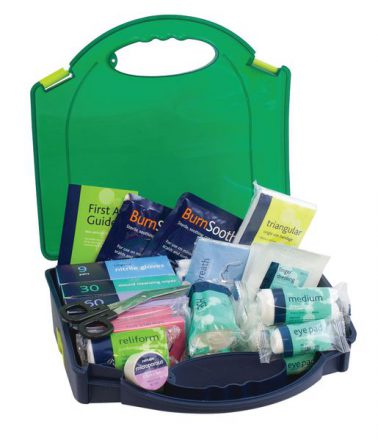Essential First Aid Kit contents
 Every home and every workplace should have a first aid kit. It is good practice to also carry a first aid kit in your car or any other vehicle, so you have essential items at hand if needed. It’s very simple to organise a kit and to check it regularly in case some items have gone past their usable date. Here is a brief guide to what you need to know when organising your first aid equipment.
Every home and every workplace should have a first aid kit. It is good practice to also carry a first aid kit in your car or any other vehicle, so you have essential items at hand if needed. It’s very simple to organise a kit and to check it regularly in case some items have gone past their usable date. Here is a brief guide to what you need to know when organising your first aid equipment.
Employer legislation
As an employer, you are required under the Health and Safety (First Aid) Regulations 1981 to provide appropriate and adequate first aid facilities, equipment and training to personnel. This is so that your employees are able to get medical attention immediately if they fall ill at work or get injured. Even if yours is a small organisation with less than five workers or if you are self-employed, these regulations still apply.
When you undertake your first aid needs assessment, you will be able to identify what is appropriate for your workplace. Larger companies may opt to provide a first aid room where injured or ill employees can be treated. Smaller companies may stock a first aid cabinet or box, according to their type of business and requirements.
While the regulations don’t constitute a legal duty to make provisions for non-employees, the Health and Safety Executive (HSE) strongly advises that non-employees, such as visitors to your business, are taken into account during workplace first aid assessments.
Workplace first aid assessments
To make sure you provide the right items for your workplace, you need to undertake a needs assessment that takes into account the number of employees you have and what sorts of tasks they perform as part of their daily work routines. Essentially, you are required to think about any potential hazards in your workplace and to put in place measures to promptly deal with any employee or visitor who has an accident.
For example, you may need different items in your workplace first aid kit, depending on whether your employees:
- Work with hazardous substances
- Use power tools
- Work outdoors
- Work at heights
- Drive warehouse vehicles or equipment
- Lift heavy goods
In most workplaces, there are employees who are designated first aiders. They should have received appropriate training and have been issued with a valid certificate to demonstrate their competence. It’s always useful to have more than one trained first aider so that you are covered when someone is absent from work or on holiday. In larger organisations, it is mandatory to have a number of qualified people trained to administer first aid.
We have more specific guidance for first aid in the office.
Self-employed workers
If you are self-employed or a freelancer, you are also required to make sure you have first aid equipment that is appropriate and adequate to your circumstances. This is so that you can provide first aid to yourself and your employees. As with other workplaces, you should assess the risks and hazards in your workplace, even if this is in your home, and decide what is the most appropriate level of first aid equipment you need.
For example, if you carry out activities involving low level hazards (for example, administrative work) in your own home, you would only be expected to provide first aid equipment according to your normal domestic needs. If you share premises with other employed and self-employed people, HSE advises that there should be a written agreement in place covering first aid provision.
If you regularly drive or commute for long distances, or you are continuously on the move, you may decide to keep a personal first aid kit in your car or other vehicle.
Offshore workers
Working remotely can make it difficult to get easy access to health care expertise. However, there have been regulations in place since 1989 – The Offshore Installations and Pipeline Works (First Aid) Regulations – to ensure the person in control of the site provides first aid and medical facilities. As before, individual sites may have different needs which should be fully assessed. There is a detailed specification for first aid provision that has been produced by Oil and Gas UK.
Recommended items for a first aid kit
Please see our latest article updated with the latest BS 8599-1:2019 kit contents here.
Make sure you have a first aid kit contents list or inventory, so the kit can be restocked when necessary, plus a leaflet containing basic first aid information. Prescription medicines are not usually part of the kit to avoid any accidental harm, i.e. should an employee have an allergic reaction to a particular substance.
